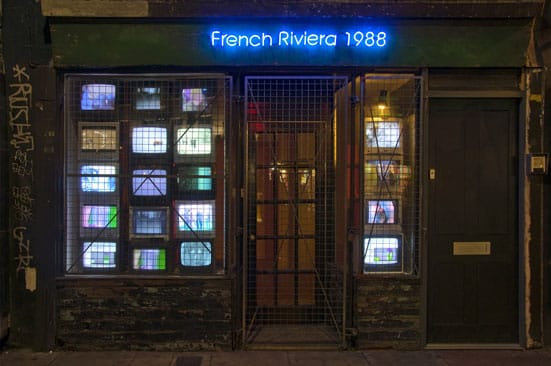1st December 2011 — 21st December 2011
Les Télévisions is a group exhibition on display at French Riviera, a project space run by artists Jennifer Lewandowski and Samuel Levack. This show presents nineteen newly created artists' silent movies by AdvertBreak, Nat Breitenstein, Sebastian Buerkner, Will Cruickshank, Samuel Dowd, Tatiana Echeverri Fernandez, Kris Emmerson, Rita Evans, Dave Farnham, Ross Jardine, Leslie Kulesh, Tom Lovell, Jon Nash, Beatriz Olabarrieta, Nick Pankhurst, Hannah Perry, Alex Ressel, Sebastiaan Schlicher and Bea Turner.
Presented on nostalgically piled analogue televisions, the silent videos are installed to be seen only from the street. Reminiscent of a nineties TV repair shop, the front iron gate gives the gallery window a Cash Converter aesthetic, while the overall display recalls a CCTV surveillance station.
Bending conventional viewing rules, the space has been left empty, whereas the viewer is invited to spy through this giant TV grid from the outside. Not every artist is given a monitor, instead the same loop containing all the videos is presented on all the screens at regular interval. This overwhelming flow of overlapping images prevents the viewer from seeing any video from one end to the other, producing a feeling of collective authorship where narratives melt together.
Rhythm is the common feature of all the presented works. With a stronger formal emphasis, the selected artists seem to respond to imposed silence with extreme visual cadence. This is particularly marked in Hannah Perry's video, where the artist translates the beats of popular R&B songs through precise editing. Stills from VHS footages are in turn frozen, duplicated or slowed down in a throbbing 'Optical Music (R&B)', as Perry's piece title suggests.
Bea Turner's 'Work War' is similarly playing on visual tempo. A real homage to Charlie Chaplin's 'Modern Times' (1936), the video can be interpreted as a questioning of contemporary work conditions. A mix of stop-motion animation, hand-made cartoon and film reveal ghost-like figures stuck in nightmarish factory assembly-line work.
If half of the pieces are using appropriated analogue videos, many works present digitally created images. As seen in Leslie Kulesh's 'She Will' where a 3D model of a stereotyped female figure serves to explore the objectification of women. Not without humour, the artist recreates the clichéd situation of a naked body dipped in chocolate with flamboyant hair slowly waving in artificial wind. Eventually escaping its master's control, the model seems to slowly creep into a monster, revealing a threatening computer mutant.
The paranoia of omnipresent and controlling artificial intelligence is also reflected in Alex Ressel's 'Moving Forward'. This work cleverly responds to the CCTV like display of Les Télévisions with a video that mimics a computer-based performance assessment. On-screen text of incomprehensible management jargon gradually turns into the ridicule of another aspect of contemporary labour.
After a first nostalgic appeal, Les Télévisions manages to challenge conventional display strategies in what should be the new form of public art. What is more, in an attempt to slow down the viewer's viewing ritual, one simple production rule - the removal of sound - allows the selected artists to reveal purely powerful images.
Elise Lammer
French Riviera
309 Bethnal Green Road
London E2 6AH
http://www.frenchriviera1988.com/

Les Télévisions at French Riviera, December 2011